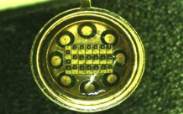Multi-Wavelength LEDs


This category of our LED products includes many versions of devices. They all include at least two LEDs of different wavelengths contained within one discrete addressable LED package. The packages can be addressed for single colors in a sequential or pulsed manner, and or in a “blended” constant color or hue. There are Visible, UV & IR LED varieties or combinations offered based on the application. Applications include creating white light without photo- conversion which typically utilizes a Blue LED and Green phosphor; fluorescing specimens within diagnostic or research instrumentation; reflecting various wavelengths off specimens for intrinsic property analysis; various treatment and photo-dynamic therapy applications; different types of photo- catalyzation and/or photo-initiation techniques; sensing, imaging and communications applications, etcetera. MARUBENI-OPTO™ offers various types and can provide custom types made to order for your specific needs. Current combinations include: First we have Near IR and IR wavelength combinations. These combinations of 2, 3 and 4 LEDs. Uses include those for diagnostic, instrumentation, machine vision, wound healing and other types of applications:

| Near IR & IR Multi-Wavelength Single Discrete LED Components Manufactured | |||||
| 635,760nm | 730,850nm | 760,840nm | 1050,1300nm | 770,805,870nm | 660,735,805,940nm |
| 660,850nm | 735,850nm | 760,850nm | 640,700,910nm | 850,890,940nm | 660,735,850,975nm |
| 660,890nm | 735,890nm | 760,940nm | 660,805,940nm | 850,940,1050nm | 660,735,840,1300nm |
| 660,910nm | 750,850nm | 760,810nm | 660,805,975nm | 850,940,1300nm | 660,805,1200,1300nm |
| 660,940nm | 700,940nm | 770,840nm | 730,805,850nm | 1200,1300,1450nm | 660,850,940,1300nm |
| 680,720nm | 730,850nm | 830,940nm | 735,780,810nm | 1300,1450,1550nm | 660,735,840,1300nm |
| 700,940nm | 760,810nm | 850,940nm | 735,805,850nm | For Other Product Designs, Make An Inquiry | |
Other wavelength combinations include: Near UV405nm with 850nm IR; UV-A 395nm with VIS 525nm and 940nm IR, as well as VIS 569nm and 660nm with 805 & 940nm IR. Standard Visible (VIS) wavelength combinations include:
| Visible (VIS) Multi-Wavelength Single Discrete LED Components Manufactured | ||||
| 430,565 nm | 565,660 nm | 430,505,568nm | 470,590,630nm | 568, 635,760nm |
| 505,630 nm | 470,525,645nm | 470,525,630nm | 525,590,630nm | 569,660,805,940nm |
Among the Visible (VIS) combinations there are several standout multi-wavelength discrete LED components, including:
Purple LEDs:
Using 470nm Blue and 660nm Red Primary Color LEDs in a single package, a complimentary “Purple” color LED can be made which can be addressed and modulated to provide any color Purple or “Pink” that is of interest for signage, display and lighting applications.
“Digital White” LEDs:
Utilizing monochromatic LED die in a singke discrete package, the user can make White light more cost effectively, brighter and with a broader spectrum of light, while avoiding the energy losses associated with producing white light via conventional (phosphor- converted blue) LEDs, aka “Analog White” LEDs.
Bi-chromatic White LEDs:
Utilizing Amber (598nm) combined with Cyan (505nm) LEDs, can enable a very cost effective “White” light option. This technology utilizes only mono- chromatic LEDs to achieve White light, not photo-conversion techniques utilizing an LED-pump and phosphor technology. With Amber and Cyan LEDs the Planckian or Black Body Curve (1931 CIE Chromaticity Chart) can be intersected, to create a warm White hue.
RGB LEDs:
Using the Red, Green and Blue Primary Colors creates an LED that can produce 68 billion colo They are used for architectural lighting, full color dot matrix displays and backlight units (BLUs) as well as color strips, entertainment lighting and more. Additionally RGB LEDs can be used to provide White Solid-State Lighting (SSL), with “white” light produced in various °Kelvin color temperatures. For example, Equal Energy White (EEW) can be created with a drive current share of (approximately) Green 60%, Red 22% and Blue 18% to arrive at an EEW locus on the Planckian or Black Body Curve (reference the 1931 CIE Chromaticity Chart). You can literally dial in any “color” White Light desired. RGB LEDs are truly “Digital White” lighting.
RGB-A LEDs:
By adding Amber to the RGB LEDs in one discrete package (quadri- chromatic) a broad spectrum White light can be found to be quite useful. Demonstrates twice the efficiency of current amber LEDs, emits more white light, with an increase in luminosity, avoids Stokes-shift energy losses while minimizing photo-carrier losses, and improves color with a color rendering index (CRI) greater than 95.
Polychromatic LEDs:
RGB-AC (Amber & Cyan) quinti-chromatic LEDs can be used for special lighting applications wherein there is a high importance for color accuracy and color rendering in the vision triang They can be used to cover the entire range of reasonable general CRI values while achieving a quasi-continuous broadband spectrum.
Red/Green LEDs:
Used mainly in various message signs and decorative lighting application, these LEDs can provide Red only, Green only and when modulated in combiination a Amber hue as well. Check out our Multi-Wavelength LEDs and let us know what you think. If you cannot find what you want from our standard selection, just let us know and we can respond accordingly with what you want.
Link: Bicolor Multicolor LEDs, SMBB, SMT